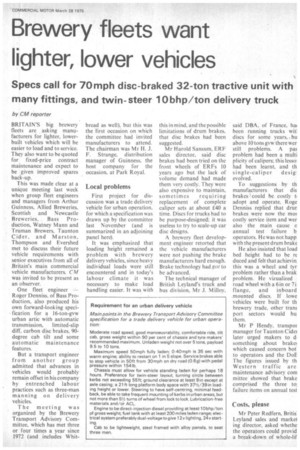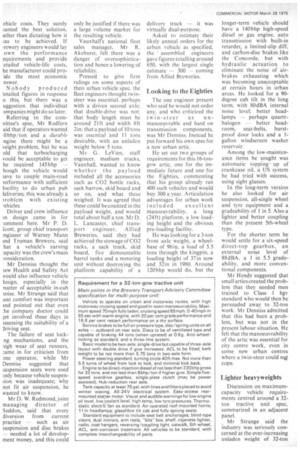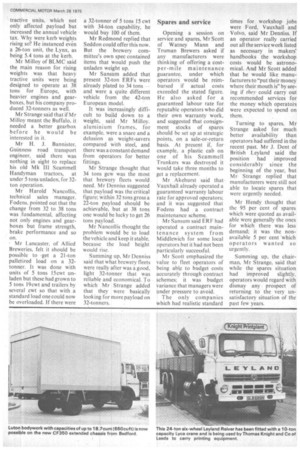Brewery fleets want lighter, lower vehicles
Page 17

Page 18

Page 19

If you've noticed an error in this article please click here to report it so we can fix it.
Specs call for 70 mph disc-braked 32-ton tractive unit with many fittings, and twin-steer 10 bhp/ton delivery truck
by CM reporter
BRITAIN'S big brewery fleets are asking manufacturers for lighter, lowerbuilt vehicles which will be easier to load and to service. They also want to be quoted for fixed-price contract maintenance and expect to be given improved spares back-up.
This was made clear at a unique meeting last week when group fleet engineers and managers from Arthur Guinness, Allied Breweries, Scottish and Newcastle Breweries, Bass Production, Watney Mann and Truman Brewers, Taunton Cider, and Marston, Thompson and Evershed met to discuss their future vehicle requirements with senior executives from all of Britain's main commercial vehicle manufacturers. C,41 was invited to be present as an observer.
One fleet engineer — Roger Denniss, of Bass Production, also produced his own forward-looking specification for a 16-ton-gvw urban artic with automatic transmission, limited-slip diff, carbon disc brakes, 90degree cab tilt and some automatic maintenance features.
But a transport engineer from another group admitted that advances in vehicles would probably remain offset in his company by entrenched labour practices such as three-man manning on delivery vehicles.
The meeting was organized by the Brewery Transport Advisory Committee, which has met three or four times a year since 1972 (and includes Whit
bread as well), but this was the 'first occasion on which the committee had invited manufacturers to attend. The chairman was Mr II. J. F. Strange, distribution manager of Guinness, the host company for the occasion, at Park Royal.
Local problems
First project for discussion was a trade delivery vehicle for urban operation, for which a specification was drawn up by the committee last November (and is summarized in an adjoining panel here).
It was emphasized that loading height remained a problem with brewery delivery vehicles, since heavy individual loads were still encountered and in today's labour climate it was necessary to make load handling easier. It was with this in mind, and the possible limitations of drum brakes, that disc brakes had been suggested.
Mr Harold Sansurn, ERF sales director, said disc brakes had been tried on the front wheels of ERFs 10 years ago but the lack of volume demand had made them very costly. They were also expensive to maintain, sometimes requiring replacement of complete caliper sets at about £40 a time. Discs for trucks had to be purpose-designed; it was useless to try to scale-up car disc designs.
A brewery fleet development engineer retorted that the vehicle manufacturers were not pushing the brake manufacturers hard enough. Brake technology had got to be advanced.
The technical manager of British Leyland's truck and bus division, Mr J. Milloy, said DBA, of France, hai been running trucks witl discs for some years, bu above 10 tons gvw there wer still problems. A pas problem had been a multi plieity of calipers; this lessol had been learnt, and th
single-caliper desig. evolved.
To suggestions by th manufacturers that dis brakes' could be costly ti adopt and operate, Roge Denniss replied that drur brakes were now the mos costly service item and wer also the main cause annual test failure b operators. He was not happ with the present drum brake
He also insisted that load bed height had to be re duced and felt that achievin, this was a wheel and tyr problem rather than a brak problem. He vizualized road wheel with a 6in or 7i flange, and inboard .mounted discs. If lowe vehicles were built for th brewery trade, other trans port sectors would bu them.
Mr P Hendy, transpor manager for Taunton Cidei later urged makers to d. something about brakes which caused concern hot. to operators and the DoE The figures issued by th Western traffic are maintenance advisory com mittee showed that brake comprised the three toi failure items on annual test
Costs., please
Mr Peter Redfern, Britis Leyland sales and market ing director, asked whethe the operators could provid a break-down of whole-lif ehicle costs. They surely /anted the best solution, ather than dictating how it /as to be achieved. If
,rewery engineers would lay own the performance
equirements and provide etailed vehicle-life costs, he manufacturer could proide the most economic nswer.
Nobody produced letailed figures in response o this, but there was a uggestion that individual ompanies might do so later.
Referring to the comnittee's spec, Mr Redfern aid that if operators wanted °bhp/ton and a durable .ngine there might be a veight problem, but he was old that turbocharging vould be acceptable to get he required 145 bhp — hough the vehicle would lave to couple main-road )erformance with sufficient locility to do urban pub leliveries; this was already a )roblem with existing eh ides.
Driver and crew influence )n design came in for :omment here. Mr P. D. ;colt, group chief transport ;ngineer. of Watney Mann trid Truman Brewers, said hat a vehicle's earning ;apacity was the crew's main ;onsideration,
Mr Denniss thought the iew Health and Safety Act mould also influence vehicle lesign, especially in the natter of acceptable in-cab loise. Mr Strange said that ieat comfort was important ind pointed out that even he company doctor could et involved these days in issessing the suitability of a iriving seat.
The failure of seat lockng mechanisms, and the ligh wear of seat runners, :ame in for criticism from 3ne operator, while Mr Denniss suggested that mspension seats were used Dilly because vehicle sus pen;ion was inadequate; why not fit air suspension, he wanted to know.
Mr D. W. Redmond, joint managing director of Seddon, said that every diversion from current practice — such as air suspension and disc brakes — needed a lot of development money, and this could only be justified if there was a large volume market for the resulting vehicle.
Vauxhall's national fleet sales manager, Mr R. Akehurst, felt there was a danger of oversophistication and hence a lowering of
Pressed to give firm rulings on some aspects of their urban vehicle spec, the fleet engineers thought twinsteer was essential, perhaps with a driven second axle; that double-drive was not: that body length must be around 21 ft and width 8ft 2in; that a payload of 10 tons was essential and I I tons desirable, with an unladen weight below 5 tons.
Mr G. LeVien, staff engineer, medium trucks. Vauxhall. wanted to know whether the payload included all the accessories such as CO2 bottle racks, sack barrow, skid board and so on, and what these weighed. It was agreed that these could be counted in the payload weight, and would total about half a ton. Mr D. L. Lancaster, chief transport engineer, Allied Breweries, said they had achieved the stowage of CO2 racks, a sack truck, skid board, five demountable barrel tanks and a metering unit without destroying the platform capability of a
delivery truck — it was virtually dual-purpose.
Asked to estimate their likely annual orders for the urban vehicle as specified, the ' assembled engineers gave figures totalling around 650, with the largest single estimate — 300 — coming from Allied Breweries.
Looking to the Eighties.
The one engineer present who said he would not order any. and who criticized the
twin-steer as unmanoeuvrable and hard on transmission components, was Mr Denniss. Instead he put forward his own spec for a new urban artic.
He set out two groups of requirements for this 16-tongvw artic, one for the immediate future and one for the Eighties, commenting that his group already ran 400 such vehicles and would buy 300 a year. Articulation advantages for urban work included excellent manoeuvrability, a long (24 ft) platform, a low loading height and the obvious pre-loading facility.
He was looking for a 3-ton front axle weight, a wheelbase of 96 in, a load of 5.5 tons through the kingpin, a loading height of 37 in now and 32in in 1980. Around I 20 bhp would do, hut the longer-term vehicle should have a 140bhp high-speed diesel or gas engine, auto transmission with built-in retarder, a limited-slip cliff, and carbon-disc brakes like the Concorde, hut with hydraulic actuation to eliminate the noise of airbrakes exhausting which was becoming unacceptable at certain hours in urban areas. He looked for a 90degree cab tat in the long term. with 80dBA internal noise level; better headlamps — perhaps quartz'halogen — better headroom, seat-belts, burstproof door locks and a 1gallon windscreen washer reservoir.
Among the low-maintenance items he sought was automatic toppingup of crankcase oil, a US system he had tried with success, using sight glasses.
In the long-term version he also looked for air suspension, all-single wheel and tyre equipment and a gradeability of 1 in 5. Also a lighter and better coupling than the present 5th-wheel type.
For the shorter term he would settle for a six-speed direct-top gearbox, an external noise level of 88 dBA, a I in 5.5 gradeability, and more conventional components.
Mr Hendy suggested that small artics created the problem that they needed men trained to Class 1 hgv standard who would then be persuaded away to 32-ton work. Mr Denniss admitted that this had been a problem, but was not in the present labour situation. He felt that the manoeuvrability of the artic was essential for city centre work, even in some new urban centres where a twin-steer could ncil cope.
Lighter heavyweights
Discussion on maximumcapacity vehicle requirements centred around a 32ton tractive unit spec, summarized in an adjacent panel.
Mr Strange said the industry was seriously concerned at the ever-increasing unladen weight of 32-ton tractive units, which not only affected payload but increased the annual vehicle tax. Why were kerb weights rising so? He instanced even a 26-ton unit, the Lynx, as being 5.4 tons at the kerb.
Mr Milloy of BLMC said the main reason for rising weights was that heavy tractive units were being designed to operate at 38 tons for Europe, with heavier engines and gearboxes, but his company produced 32-tonners as well.
Mr Strange said that if Mr Milloy meant the Buffalo, it needed a better gearbox before he would be interested in it.
Mr H. J. Bannister, Guinness road transport engineer, said there was nothing in sight to replace his old Mk III Scammell Handyman tractors, at under 5 tons unladen, for 32ton operation.
Mr Harold Nancollis,, technical sales manager. Fodens, pointed out that the change from 32 to 38 tons was fundamental, affecting not only engines and gearboxes but frame strength, brake performance and so on.
Mr Lancaster. of Allied Breweries, felt it should be possible to -get a 21-ton palletized load on a 32tonner. It was done with units of 5 tons 15ewt unladen but these had grown to 5 tons 19 cwt and trailers by several cwt so that with a standard load one could now be overloaded. If there were a 32-tonner of 5 tons 15 cwt with 34-ton capability, he would buy 100 of them.
Mr Redmond replied that Seddon could offer this now. But the brewery committee's own spec contained items that would push the unladen weight up.
Mr Sansum added that present 32-ton ERFs were already plated to 34 tons and were a quite different vehicle from the 42-ton European model.
It was increasingly difficult to build down to a weight, said Mr Milloy. aluminium frames, for example, were a snare and a delusion as weight-savers compared with steel, and there was a constant demand from operators for better fittings.
Mr Strange thought that 34 tons gcw was the most that brewery fleets would. need. Mr Denniss suggested that payload was the critical figure; within 32 tons gross a 22-ton payload should be achievable, but at 38 tons one would be lucky to get 26 tons payload.
Mr Nancollis thought the problem would be to load the vehicle and keep it stable, because the load height would rise.
Summing up, Mr Denniss said that what brewery fleets were really after was a good, light 32-tonner that was reliable and economical. To which Mr Strange added that they were basically looking for more payload on 32-tonners.
Spares and service
Opening a session on service and spares, Mr Scott of Watney Mann and Truman Brewers asked if any manufacturers were thinking of offering a costper-mile maintenance guarantee, under which operators would be reimbursed if actual costs exceeded the stated figure. He also asked for a guaranteed labour rate for, reputable operators who did their own warranty work, and suggested that consignment stocks of spares should be set up at strategic points, on a sale-or-return basis. At present if, for example, a plastic cab on one of his Scammell Trunkers was destroyed it would take three months to get a replacement.
Mr Akehurst said thatVauxhall already operated a guaranteed warranty labour rate for approved operators; and it was suggested that Fodens had a contract maintenance scheme.
Mr Sansum said ER F had operated a contract maintenance system from Middlewich for some local operators but it had not been particularly successful.
Mr Scott emphasized the value to fleet operators of being able to budget costs accurately through contract schemes; it was budget variance that managers were under pressure to avoid.
The only companies which had realistic standard times for workshop jobs were Ford, Vauxhall and Volvo, said Mr Denriiss. If an operator really carried out all the service work listed as necessary in makers' handbooks the workshop costs would be astronomical. And Mr Scott added that he would like manufacturers to "put their money where their mouth is" by seeing if they could carry out recommended services for the money which operators were expected to spend on them.
Turning to spares, Mr Strange asked for much better availability than operators had suffered in the recent past. Mr J. Dent of British Leyland said the position had improved considerably since the beginning of the year, but Mr Strange replied that manufacturers were still not able to locate spares that were urgently needed.
Mr Hendy thought that the 95 per cent of spares which were quoted as available were generally the ones for which there was less demand; it was the nonavailable 5 per cent 'which operators wanted so urgently.
Summing up, the chairman, Mr Strange, said that while the spares situation had improved slightly, operators would regard with dismay any prospect of returning to the very unsatisfactory situation of the past few years.




























































































